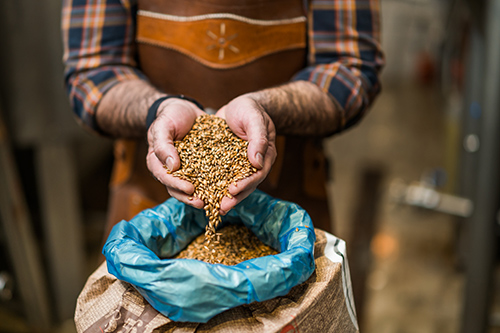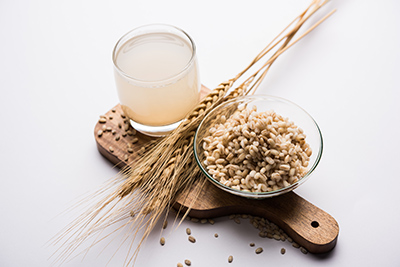Contents
Barley health benefits are many. However, before we get into them, let’s learn more about this grain. Although it has been cultivated since the remotest of times, barley has always been considered a poor relation to wheat. Developing countries, particularly in Asia, take full advantage of it for food, often mixing it with rice. In more affluent countries, however, more than half of the barley production is used for animal feed. Most of the other half is used to make malt, beer, and whiskey. A small portion is used to feed humans.
Experts foresee an increase in the world’s population without a corresponding increase in food resources. This means that many tons of barley must be used to feed humans rather than feeding livestock for meat. When this happens, human health will be better for it.

Barley Nutritional Facts
Barley, whole-grain or polished, is very similar in composition to wheat, with some significant differences:
- Proteins: Barley’s percentage of proteins is somewhat higher (12.5 percent) than wheat (11.3 percent) while containing less gluten. Because of this, barley bread is more compact and less spongy than that made with wheat. Barley proteins are also deficient in lysine. However, this lack is minimized by combining barley with legumes or dairy products rich in lysine.
- Carbohydrates: Barley contains 56.2 percent, somewhat less than wheat (61.7 percent). The carbohydrates of both grains are in the form of starch. This is digested more easily when ground to a fine flour, as opposed to the whole grain (cooked barley, flakes). However, barley is most digestible when malted as grain, flour, or liquid malt.
- Vitamins: Barley contains more vitamins B1 and B2 than wheat but only half as much vitamin E. As with all grains, it lacks provitamin A, C, and B12.
- Minerals: Its composition is similar to wheat: rich in phosphorus, magnesium, iron, zinc, and other trace elements. However, like wheat, it is poor in calcium.
- Fiber: Barley contains 17.3 grams of cellulose fiber per 100 grams, about 5 grams more than wheat. Alternatively, pearl barley and the flour it is made from possess fewer nutrients since they are refined, as is the refined white wheat flour. During polishing, barley can lose seventy-four percent of its protein content, eighty-eight percent of its vitamins and minerals, and ninety-seven percent of its fiber. Malted grain or flour contains more nutrients than pearl barley since it has not been as refined. It is more digestible because of its richness in enzymes. It is tastier than barley because it has been toasted.
Barley Health Benefits
Barley is indicated in the following cases:

Digestive disorders: Pearl barley, barley flour, and primarily malt granules and flour are well tolerated by weak stomachs. They are helpful in gastritis dyspepsia (indigestion), gastroduodenal ulcers, gastroenteritis, and colitis. Barley water and malt beverages are also of great value in cases of digestive distress. As with wheat and rye, barley should be avoided by those with celiac disease.
Excess cholesterol: Eating barley in any form: whole grain (polished), flakes, whole-grain flour, or partially whole-grain (malted grain and flour) produces a reduction in total cholesterol level, LDL (harmful) cholesterol level, and triglycerides. This was shown to be the case by the Institute of Health and Nutrition of Tokyo when half of the daily rice allotment of a group of patients suffering from elevated cholesterol was replaced with barley.
As with all whole grains, barley consumption has been shown to prevent arteriosclerosis. It should be integrated into the diet of those at high risk of coronary disease.
Diabetes: Diabetic laboratory animals fed barley showed lower blood glucose levels than those provided on wheat. This effect is attributed to some hypoglycemic factor in barley that is still being investigated. Varieties of barley rich in fiber and beta-glucan (a cellulose derivative also found in oats) are better tolerated by people with diabetes. Today, barley and other grains containing slow-releasing starch are recommended for patients with this disease.
Intestinal disorders: Barley fiber helps prevent constipation and all its complications, including colon cancer.
Barley Scientific Facts
- Scientific name: Hordeum vulgare L.
- Other names: Barleycorn, Barley Flakes, Malt.
- French: Orge.
- Spanish: Cebada.
- German: Gerste.
- Description: The fruit of the barley plant is a herbaceous plant of the botanical family Gramineae.
- Environment: Barley originated in the mountainous areas of southwest Asia and was cultivated several millennia before Christ. It has expanded to all world regions because it is adaptable to various soils and climates. The primary producing countries are Russia, Germany, and Canada.
Barley Water

Barley water is prepared by boiling 50 to 100 grams of barley, preferably pearl, in enough water so that one liter remains after half an hour of cooking. This broth, barley water, is rich in starch and minerals. Lemon juice may be added. It is recommended in these cases:
Diarrhea and colitis because it protects the intestinal mucosa.
Dyspepsia (indigestion) due to indigestion or functional disorders of the digestive system.
Debilitating disease or any time the digestive system is weakened. In this case, it may be sweetened with sugar or honey.
Care When Cooking
Cooking barley in a pressure cooker produces starchy foam that can plug the safety valve and cause an accident. To avoid this, add a little oil to the water with the barley.

How to Use and Prepare Barley
- Polished barley (whole grain): Barley has its indigestible outer shell (glume) and part of the bran removed by abrasion. After soaking in water, it is boiled with vegetables or cooked as a soup for an hour.
- Pearl barley (refined): Barley that has been polished until the glume, the bran, and most of the germ have been removed. The result is a polished, round, uniform grain. It is boiled like rice, although its flavor is more intense. It requires a minimum of 35 minutes of cooking.
- Barley water: See instructions above.
- Flakes: These are prepared with soaked, boiled, and pressed grain. They are used as part of muesli or cooked for ten minutes in milk or vegetable broth.
- Flour: This can be made from polished (whole-grain) or pearl (refined) barley.
- Malt: This is an aqueous extract of barley that has been germinated and roasted.
DISCLAIMER: All content on this website is presented solely for educational and informational objectives. Do not rely on the information provided as a replacement for advice, diagnosis, or treatment from a qualified medical expert. If you are pregnant, nursing, or have any preexisting medical concerns, talk to your doctor before using any herbal or natural medicines.
References
- George D. Pamplona-Roger, M.D. “Encyclopedia of Foods and Their Healing Power.” George D. Pamplona-Roger, M.D. Encyclopedia of Foods and Their Healing Power. Trans. Annette Melgosa. Vol. 2. Chai Wan: Editorial Safeliz, 2005. 162, 163. Print. [Barley Health Benefits]
- Whitehead A, Beck EJ, Tosh S, Wolever TM. Cholesterol-lowering effects of oat beta-glucan: a meta-analysis of randomized controlled trials. Am J Clin Nutr. 2014 Nov;100(5):1413-21. doi: 10.3945/ajcn.114.086108. Epub 2014 Sep 10. PMID: 25212253.
- Behall KM, Scholfield DJ, Hallfrisch J. Diets containing barley significantly reduce lipids in mildly hypercholesterolemic men and women. Am J Clin Nutr. 2004 Sep;80(3):689-95. doi: 10.1093/ajcn/80.3.689. PMID: 15321796.
- Weaver CM, Heaney RP. Calcium. In: Erdman JW Jr, Macdonald IA, Zeisel SH, editors. Present Knowledge in Nutrition. 10th ed. Washington, DC: Wiley-Blackwell; 2012. pp. 256-73.
- National Institute of Diabetes and Digestive and Kidney Diseases: https://www.niddk.nih.gov/health-information/digestive-diseases/celiac-disease
- Oldways Whole Grains Council: https://wholegrainscouncil.org/
- National Institutes of Health (NIH): https://www.nih.gov/
- PubMed: https://www.ncbi.nlm.nih.gov/
